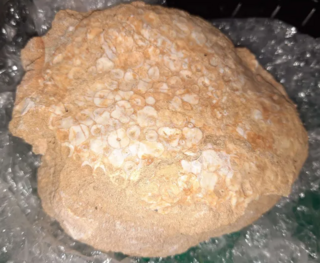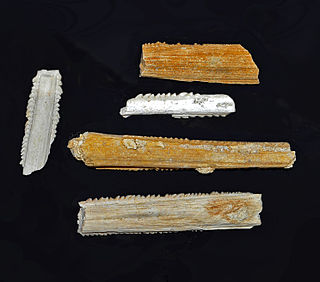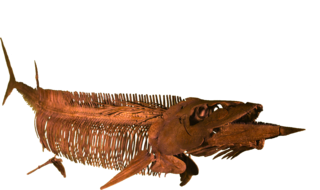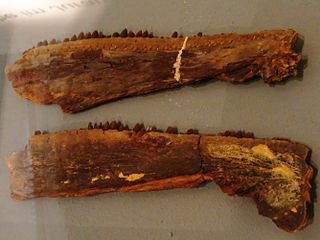
Sawfish, also known as carpenter sharks, are a family of rays characterized by a long, narrow, flattened rostrum, or nose extension, lined with sharp transverse teeth, arranged in a way that resembles a saw. They are among the largest fish, with some species reaching lengths of about 7–7.6 m (23–25 ft). They are found worldwide in tropical and subtropical regions in coastal marine and brackish estuarine waters, as well as freshwater rivers and lakes. All species are critically endangered.

Enchodus is an extinct genus of aulopiform ray-finned fish related to lancetfish and lizardfish. Species of Enchodus flourished during the Late Cretaceous, where they were a widespread component of marine ecosystems worldwide, and there is some evidence that they may have survived to the Paleocene or Eocene; however, this may just represent reworked Cretaceous material.
The deep-sea smelts are any members of the family Bathylagidae, a distinct group of marine smelts.

Sclerorhynchus is an extinct genus of ganopristid sclerorhynchoid that lived during the Late Cretaceous. The genus Ganopristis is considered a junior synonym of Sclerorhynchus. It was a widespread genus, with fossils found in the Middle East, North Africa, Europe, and North America. While it had a long rostrum with large denticles similar to sawfishes and sawsharks, its closest living relatives are actually skates. Complete specimens of S. atavus show that its fin arrangement was similar to skates, with the pectoral and pelvic fins touching, both dorsal fins located behind the pelvic fins, and a reduced caudal fin.

The smalltooth sawfish is a species of sawfish in the family Pristidae. It is found in shallow tropical and subtropical waters in coastal and estuarine parts of the Atlantic. Reports from elsewhere are now believed to be misidentifications of other species of sawfish. It is a critically endangered species that has disappeared from much of its historical range.

Coriops is an extinct genus of freshwater osteoglossomorph fish, possibly a hiodontiform, with a single species known from the Late Cretaceous of western North America.

Eodiaphyodus is an extinct genus of marine phyllodont ray-finned fish known from Late Cretaceous sediments across Africa. As with other members of its family, it is primarily known by its fossilized tooth plates, which were likely found in the back of its throat and used to crush its food.

Rhombodus is a prehistoric genus of ray belonging to the family Rhombodontidae.

Schizorhiza is an extinct genus of schizorhizid sclerorhynchoid that lived during the Late Cretaceous. It contains one valid species, Schizorhiza stromeri. It lived from the Campanian to Maastrichtian, and its fossils have been found in Africa, the Middle East, North America, and South America.

Conulus is an extinct genus of echinoids that lived in the Cretaceous. Remains of Conulus species have been found in Asia, Europe, and North America.

Phyllodus is an extinct genus of bony fish from the Maastrichtian to Middle Miocene. Fossils of the genus have been found in the Maastrichtian to Danian Hell Creek Formation, the Eocene London Clay, the Early eocene Nanjemoy formation. and the Paleocene of South Carolina.

Saurodon is an extinct genus of ichthyodectiform ray-finned fish from the Late Cretaceous.
Protoscaphirhynchus squamosus is an extinct sturgeon from the Late Cretaceous of North America. It is known from a single poorly preserved specimen found in the Maastrichtian aged Hell Creek Formation in Montana. Due to its poor preservational state, it has few diagnostic characters.
Ampheristus is an extinct genus of prehistoric marine ray-finned fish. It was a basal or stem member of the family Ophidiidae, which contains modern cusk-eels. Fossils are known from worldwide from the Late Cretaceous to the late Paleogene, making it a rather successful survivor of the Cretaceous-Paleogene extinction event.

Saurocephalus is an extinct genus of ray-finned fishes within the family Saurodontidae. The genus was first described in 1824 and contains six or seven species, including the type species S. lanciformis. Saurocephalus first appeared during the early Valanginian and continued on to the Maastrichtian, where it nearly went extinct. However, the recent discovery of S. lanciformis remains from the earliest Paleocene indicates that it just barely survived into the Cenozoic. This would make it the last surviving ichthyodectiform.
Egertonia is an extinct genus of prehistoric marine and estuarine ray-finned fish known from the Late Cretaceous to the middle Eocene. It contains one known species, E. isodonta, although indeterminate remains potentially referable to other species are also known. It was a member of the Phyllodontidae, an extinct family of elopomorph fish with crushing tooth plates, which are the primary remains found of the genus.

Pristis is a genus of sawfish of the family Pristidae. These large fish are found worldwide in tropical and subtropical regions in coastal marine waters, estuaries, and freshwater lakes and rivers. Sawfish have declined drastically and all species are considered critically endangered today.

Zarafasaura is an extinct genus of elasmosaurid known from the Ouled Abdoun Basin of Morocco. As a relatively small elasmosaur, it would have measured around 3–4 metres (9.8–13.1 ft) long and weighed about 100 kilograms (220 lb).

Schizaster is a genus of heart urchins belonging to the family Schizasteridae. The type species of the genus is Schizaster studeri.

Echinolampas is a genus of echinoderms belonging to the family Echinolampadidae.
















